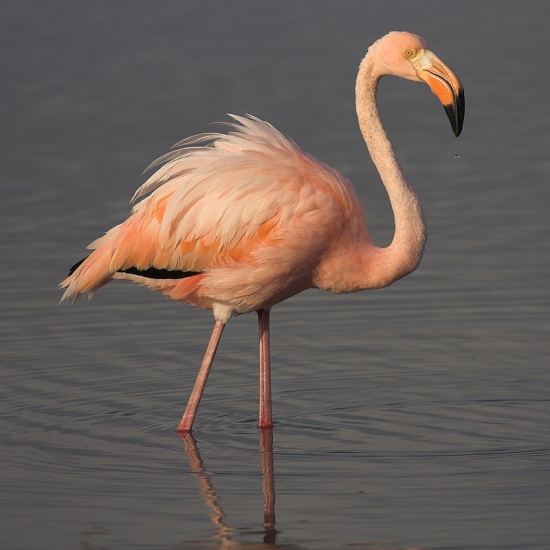- Phoenicopterus ruber
Alternative name: Caribbean Flamingo
Identification
120-145 cm (49-58 inches). Deep pink- orange plumage, bill - black tip, red-orange middle, pale yellow near eye, long neck and legs, light yellow iris.
Juvenile is greyish overall, changing first to white and then as carotenoids from the food builds up, to the pink that the adults are known for.
Distribution
Caribbean, Mexico (Yucatan Peninsula), coast of northern South America (only regular and better than rare in Venezuela, Suriname and possibly French Guiana), offshore islands such as Aruba, Bonaire, and Curaçao, and Galapagos Islands (Ecuador). Within the Caribbean probably most numerous in Cuba and Bahamas, but also common on Hispaniola.
Taxonomy
Often considered conspecific with the Greater Flamingo (Phoenicopterus roseus) of Europe, Asia, and Africa.
Subspecies
Clements recognizes these subspecies[1]:
Habitat
Feeds in shallow lagoons, preferably with high salinity. As such they cannot breed every year in all colonies, as the lagoons can be too concentrated if the rain is lacking or too diluted in the opposite case.
Behaviour
Breeding
Breeds in large colonies in nests consisting of mud compacted into a mound on top of which twigs are fixed with mud to form the nest, which is built by both sexes. 1 white egg is laid, and incubated by both parents for 27-31 days.
Diet
The diet includes small crustaceans, molluscs, and insects which are filtered from the water while the head is held upside down.
Vocalisation
References
- Clements, J. F., P. C. Rasmussen, T. S. Schulenberg, M. J. Iliff, T. A. Fredericks, J. A. Gerbracht, D. Lepage, A. Spencer, S. M. Billerman, B. L. Sullivan, M. Smith, and C. L. Wood. 2024. The eBird/Clements checklist of Birds of the World: v2024. Downloaded from https://www.birds.cornell.edu/clementschecklist/download/
- Gill, F, D Donsker, and P Rasmussen (Eds). 2024. IOC World Bird List (v 14.2). Doi 10.14344/IOC.ML.14.2. http://www.worldbirdnames.org/
- Colorado Education
External Links
Note: Results in photo search may include photos of Phoenicopterus roseus, which previously was considered a subspecies of this species (see Taxonomy).
GSearch checked for 2020 platform.1





